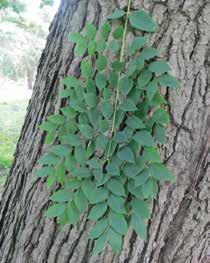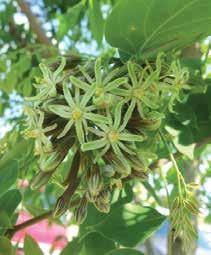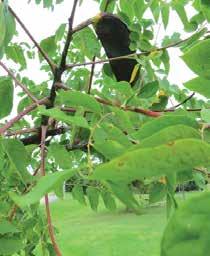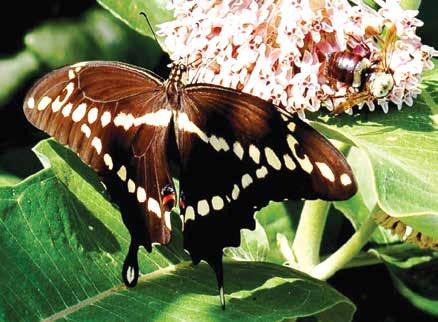
4 minute read
Kentucky Coffeetree
consider planting this under-utilized native
More than 50 percent of the 300-acre Overland Park Arboretum and Botanical Gardens is covered by naturally planted woodlands. Along with the elm, hackberry, walnut, ash, Osage Orange and many others is my favorite tree (one of them anyway), the Kentucky Coffeetree (Gymnocladus dioica). While it is not common in the Arboretum, or in any other forest, there are several Coffeetrees, along the mulched woodland paths there, one or two with tree markers. In mid-January Ken O’Dell and I strolled along the path in the Marder Woodland Garden and spotted four Coffeetrees, of varying sizes one of which had a tree marker. I would encourage you to explore the Arboretum woodlands and look for these special trees. They prefer to be near the edge of the woodlands, growing there with less competition. The Coffeetree tends to grow in small clusters as a result of root sprouting. My home golf course has a very nice grove of 30 or so Coffeetrees, no doubt due to root sprouting. I have never seen fruit on any of the trees so it is likely they are all males arising from the roots of other male trees. Very beautiful, mature and healthy Coffeetree groupings planted by humans can be seen at Black Bob Park and at Loose Park. At the Overland Park Arboretum, there is a stake marker at the foot of a young Coffeetree that was planted by humans in the Stous Promenade.
The Kentucky Coffeetree is native in Kansas and Missouri, as well as every other state in eastern America except for Florida and Louisiana. It is not very common in any of them, however. There are only two other species in the Gymnocladus genus, and both are native to Asia. The scientific name Gymnocladus dioica comes from the Greek gumnos (naked) and klados (branch) referring to the large coarse branches with no twigs after the rachis and petiole of the bipinnately compound leaves have fallen. Dioica (or dioicus) meaning the tree is dioecious – that is, male and
female flowers are borne on separate trees. The Kentucky Coffeetree is a member of the pea or legume (Fabaceae) family.
The alternate leaves of the Kentucky Coffeetree are bipinnatelycompound. The leaflets are arranged like a feather along a central rachis that is red in color. While the individual leaflets are less than two inches long, the entire leaf assembly of the Coffeetree is the largest of any North American tree, often attaining a length of three feet. They are among the last leaves to emerge in the spring allowing sunlight to reach the emerging vegetation below. The new leaves are an
attractive pink-bronze color and by summer they become a dark bluishgreen. Fall color is yellow, and contrasts nicely with the red color of the central rachises that remain on the tree for a while after the leaves have fallen. Positive identification of trees in the winter is often difficult. Spotting these long rachises on the ground below, however, confirms you are standing under a Kentucky Coffeetree.
The Coffeetree grows about 10-14 feet in 10 years, ultimately becoming 60-80 feet tall with an open irregular oval crown. Its bark is rugged and rough with scaly ridges curling outward along the edges creating a very unique bark pattern.
Flowers on the Kentucky Coffeetree occur in long terminal clusters, and the females are mildly fragrant. The panicles of the male flowers are about three inches in length, and the females 12 inches long. They are not particularly conspicuous, as they get lost amongst the new foliage. Female flowers give rise to the fruit. The large leathery seedpods are harder, shorter and straighter than the pods of the honeylocust (Gleditsia triacanthos) and create interest as they persist on the tree through winter. Inside the pods are very hard, dark brown, marble-sized seeds surrounded by a gooey pulp. Native Americans cooked these seeds to make a coffee-like drink. Although drinkable, early settlers quickly realized it was a poor substitute for the real thing. It is from this that the common name “coffee tree” was derived. The seeds of the Coffeetree are toxic when consumed without roasting. Wildlife must sense this, or they avoid the hard seed coat, as none seem to feast on them. Livestock have died from consuming the seeds. Native Americans put large quantities of the seeds in streams, lakes and ponds to stun or kill fish.
Unfortunately, the Kentucky Coffeetree is under-utilized in the landscape industry. It has no serious disease or insect problems. With its bold form, contorted branching, large handsome leaves, interesting bark and fruit, it has ornamental value in all seasons. If you have plenty of room, you should consider planting my favorite tree in your yard.
Coffeetree, Overland Park Arboretum
Photos by Jim Earnest.

Coffeetree leaf

Coffeetree flowers Fruit and Red Rachis

JIM EARNEST Local Plantsman
Jim Earnest, is on the Education Committee at the Overland Park Arboretum and Botanical Gardens and a long-time member of Kansas Native Plant Society.










